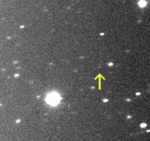Ark (moon)
| ark | |
|---|---|
| Provisional or systematic name | S / 2002 J 1 |
| Central body | Jupiter |
| Properties of the orbit | |
| Major semi-axis | 22,931,000 km |
| Periapsis | 16,992,000 km |
| Apoapsis | 28,870,000 km |
| eccentricity | 0.2588 |
| Orbit inclination | 165.0 ° |
| Orbital time | 723.9 d |
| Mean orbital velocity | 2.30 km / s |
| Physical Properties | |
| Albedo | 0.04 |
| Apparent brightness | 22.8 mag |
| Medium diameter | ~ 3 km |
| Dimensions | ~ 4.5 × 10 13 kg |
| Medium density | 2.6 g / cm 3 |
| Acceleration of gravity on the surface | ≈0 m / s 2 |
| Escape speed | ≈0 m / s |
| discovery | |
| Explorer | |
| Date of discovery | October 31, 2002 |
| Remarks | retrograde orbit |
Arche (also Jupiter XLIII ) is one of the smaller moons of the planet Jupiter .
discovery
S / 2002 J 1 was discovered by Scott S. Sheppard on October 31, 2002 . On March 30, 2005, the moon was officially named Ark by the International Astronomical Union (IAU).
The moon was named after Arche, one of the titanic muses .
Orbit data
Ark orbits Jupiter at a mean distance of 22,931,000 km in 723 days, 22 hours and 36 minutes. The track has an eccentricity of 0.2588. With an inclination of 165.001 °, the orbit is retrograde; that is, the moon moves around the planet against the direction of rotation of Jupiter.
Due to its orbital properties, Arche is assigned to the Carme group , named after the Jupiter moon Carme .
Physical data
Ark has a diameter of about 3 km. Its density is estimated at 2.6 g / cm³. It is probably made up mainly of silicate rock. It has a very dark surface with an albedo of 0.04, i.e. that is, only 4% of the incident sunlight is reflected. Its apparent brightness is 22.8 m .
Web links
- MPEC 2002-Y22: S / 2002 J 1 December 18, 2002 (discovery)
- IAUC 8035: S / 2002 J 1 December 18, 2002 (discovery)
- MPEC 2004-D43: S / 2002 J 1 February 27, 2004 (rediscovery)
- IAUC 8502: Satellites of Jupiter March 30, 2005 (numbering and naming)
- https://solarsystem.nasa.gov/planets/arche/facts
- https://planetarynames.wr.usgs.gov/Page/Planets
| before | Jupiter moons | after that |
| Thelxinoe | ark |
Callichore |
